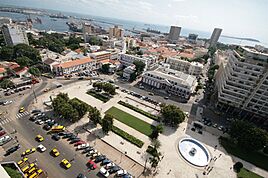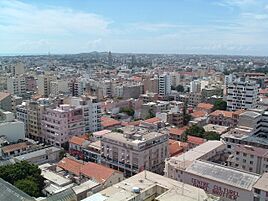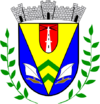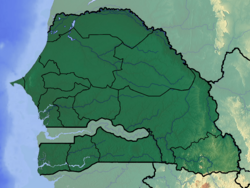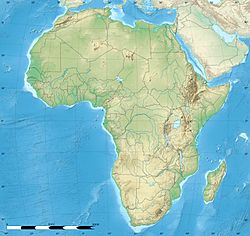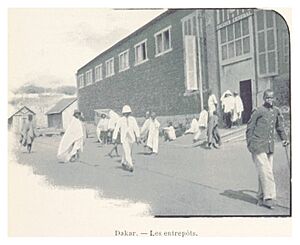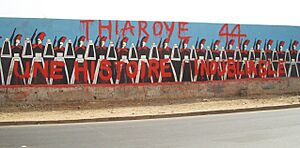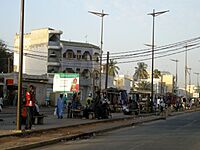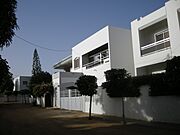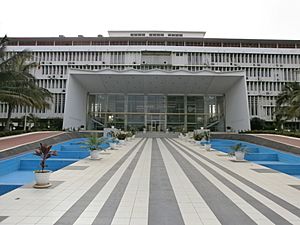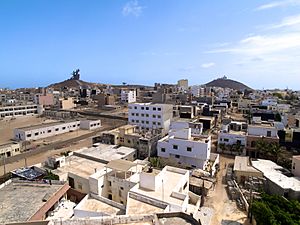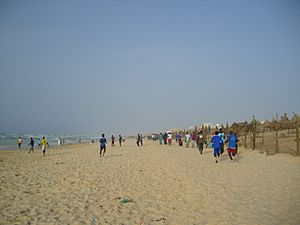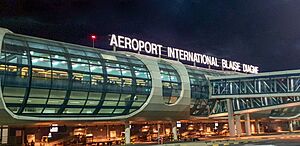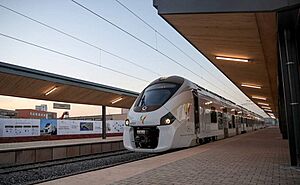Dakar facts for kids
Quick facts for kids
Dakar
|
|||
|---|---|---|---|
|
Place de l'indépendance
Maison des Esclaves in Gorée
Mosque of Divinity
Soumbedioune boats of Médina
Ngor beach
Dakar skyline
|
|||
|
|||
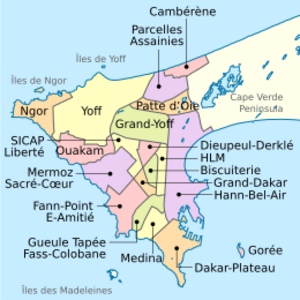
City of Dakar, divided into 19 communes d'arrondissement
|
|||
| Country | |||
| Région | Dakar | ||
| Département | Dakar | ||
| Settled | 15th century | ||
| Communes d'arrondissement |
19
Cambérène
Parcelles Assaines Pattie d'Oies Hann Bel-Air Dieuppeul Derklé HLM Biscuiterie Grand Dakar Plateau Médina Fass-Gueule Tapée-Colobane Fann Point-E Mermoz-Sacré-Coeur Ouakam Yoff Ngor Liberté Grand-Yoff Cape Verde Peninsula |
||
| Area | |||
| • Capital city | 79.83 km2 (30.82 sq mi) | ||
| • Metro | 535 km2 (207 sq mi) | ||
| Elevation | 22 m (72 ft) | ||
| Population
(2023 Census)
|
|||
| • Capital city | 1,278,469 | ||
| • Density | 16,014.9/km2 (41,478.4/sq mi) | ||
| • Metro | 4,004,427 | ||
| • Metro density | 7,485/km2 (19,390/sq mi) | ||
| Data here are for the administrative Dakar région, which matches almost exactly the limits of the metropolitan area | |||
| Time zone | UTC+00:00 (Greenwich Mean Time) | ||
| • Summer (DST) | (Not Observed) | ||
Dakar is the capital and largest city of Senegal, a country in West Africa. The city is home to about 1.2 million people. If you include the wider metropolitan area, the population is around 4 million as of 2023. This makes it a very busy and important city!
Dakar is located on the Cap-Vert peninsula, which is the westernmost point of mainland Africa. This special location has made it a key port city for centuries. The Portuguese first arrived here in the 15th century. Later, the French took control. Dakar grew into a major port and a big city within the French colonial empire. In 1902, it became the capital of French West Africa. After a short time as the capital of the Mali Federation (1959-1960), Dakar became the capital of independent Senegal in 1960. Dakar is also set to host the 2026 Summer Youth Olympics, which will be a huge event for the city and the whole continent!
Contents
History of Dakar
Dakar's history is long and interesting, showing how it grew into the important city it is today.
Early Settlements and European Arrival
The Cap-Vert peninsula was settled by the Lebu people a long time ago, even before the 15th century. They were a group of the Wolof people who lived by the water. Some of their original villages, like Ouakam, Ngor, Yoff, and Hann, are still special neighborhoods in Dakar today. In 1444, the Portuguese explorers reached the Bay of Dakar. They made peaceful contact in 1456. This bay became an important stop for Portuguese ships traveling to and from India. They would stop to fix their ships, get fresh water, and trade with the local people.
Gorée Island and the Slave Trade
The Portuguese later set up a settlement on Gorée Island, which is just off the coast. By 1536, they started using it as a base for the Atlantic slave trade. This was a sad period where many people were taken from Africa and forced into slavery. The island changed hands many times between the Portuguese, Dutch, and English. Finally, France took control in 1677. Even after France took over, families of mixed European and African heritage played a big role in the slave trade. The famous "House of Slaves" was built on Gorée in 1776.
French Influence and Growth
In the 17th century, a new Lebu village called Ndakaaru was built right across from Gorée. It helped supply the European traders with food and water. In 1795, the Lebu people living in Cape Verde revolted against the local Cayor rulers. They formed a new religious state, which the French later called the "Lebu Republic." Its capital was Ndakaaru.
In 1857, the French set up a military base at Ndakaaru, which they called "Dakar." They took control of the Lebu Republic, but the Lebu people's traditional leaders are still recognized today. France officially ended the slave trade in all its territories in 1848. To make up for this, they encouraged growing peanuts on the mainland. As the peanut trade grew, the small Gorée Island became too small to handle all the ships. Traders moved to the mainland, and a trading center was set up in Rufisque in 1840.
The French government spent a lot of money to develop Dakar. They improved the port, built a telegraph line, and completed the Dakar-Saint-Louis railway in 1885. This made Dakar an important base for France's expansion into West Africa.
Dakar as a Capital City
Dakar, including Gorée, became a French commune (like a town) in 1872. Dakar itself became a separate commune in 1887. The people of Dakar could elect their own mayor and city council. They even helped send a representative to the French National Assembly in Paris. In 1902, Dakar replaced Saint-Louis as the capital of French West Africa. Another major railway, the Dakar-Niger railway, was built from 1906 to 1923. This railway connected Dakar to Bamako and made the city even more important as the center of France's West African empire. In 1929, Gorée Island, which had only a few hundred people left, became part of Dakar.
During the colonial period, Dakar grew rapidly, but there was often segregation between different groups of people. After a plague in 1914, the authorities moved most of the African population from the old neighborhoods, called "Plateau," to a new area called Médina. This was done for "health reasons." The Lebu people, who were the first inhabitants, fought against this. They were supported by Blaise Diagne, the first African elected to the French National Assembly. Even so, the Plateau area became mostly for Europeans, housing government offices, businesses, and homes. Meanwhile, a religious group called the Layene Sufi order grew strong among the Lebu people in Yoff and Cambérène. After Senegal became independent, Dakar continued to grow, spreading eastward to Pikine and Rufisque. This created a huge urban area with almost 3 million people, which is more than a quarter of Senegal's total population.
In its colonial days, Dakar was one of the most important cities in the French Empire. Many French trading companies opened offices there. Factories like mills, breweries, and refineries were built because of its good port and railway connections. It was also important for France's military, with a large naval base and a coaling station. It was even part of early air force and airmail routes.
World War II and Independence
In 1940, Dakar became involved in World War II. General de Gaulle, the leader of the Free French Forces, wanted to make Dakar a base for his resistance efforts against the Axis powers. He planned to raise the Free French flag in West Africa. However, the city was already under the control of the Vichy government, which was allied with Germany. When French naval forces loyal to Vichy arrived, de Gaulle's plans were stopped. The Battle of Dakar took place from September 23-25, 1940, between the Vichy defenses and the Free French and British navies. De Gaulle's forces had to give up after some naval losses. Even though this plan failed, General de Gaulle was able to set up his base in Douala in Cameroon.
In November 1944, West African soldiers in the French army protested against poor conditions at the Thiaroye camp, near Dakar. This protest was a significant event for the nationalist movement that wanted independence. On December 1, 1944, French soldiers guarding the camp opened fire on the West African soldiers. This was a very sad and difficult event.
Dakar was the capital of the short-lived Mali Federation from 1959 to 1960. After that, it became the capital of independent Senegal. The first President of Senegal, Léopold Sédar Senghor, who was also a poet and philosopher, wanted to make Dakar a center of culture and learning in Africa.
Today, Dakar is a major financial hub. It has many national and regional banks, including the Central Bank of West African States (BCEAO), which manages the currency for several West African countries. Many international organizations and research centers are also located here. Dakar has a large Lebanese community involved in trade, as well as communities from Morocco, Cape Verde, and Guinea. About 20,000 French people also live in the city. France still has an air force base in Yoff, and its navy uses Dakar's port.
From 1978 until 2007, Dakar was often the finishing point of the famous Dakar Rally, a long-distance off-road race.
Geography and Climate
Dakar is located on the Cap-Vert peninsula, right on the Atlantic coast. It is the westernmost city on the African mainland, giving it a unique position.
Weather in Dakar
Dakar has a hot semi-arid climate, which means it's generally warm with a short rainy season and a long dry season. The rainy season is from July to October. The rest of the year is dry. The city gets about 411 millimeters (16 inches) of rain each year.
From December to May, Dakar is usually very warm, with daily temperatures around 25-28°C (77-82°F). Nights are warm too, around 18-20°C (64-68°F). From May to November, the city gets hotter, with daily highs reaching 29-31°C (84-88°F) and night lows a bit above 23-25°C (73-77°F). Even though it gets hotter, Dakar's weather is not as extreme as cities further inland in the Sahel region, where temperatures can be much higher. Dakar is lucky to have cool sea breezes all year round, which helps keep it from getting too hot.
| Climate data for Dakar(1991–2020) | |||||||||||||
|---|---|---|---|---|---|---|---|---|---|---|---|---|---|
| Month | Jan | Feb | Mar | Apr | May | Jun | Jul | Aug | Sep | Oct | Nov | Dec | Year |
| Mean daily maximum °C (°F) | 25.9 (78.6) |
25.2 (77.4) |
25.2 (77.4) |
25 (77) |
26.2 (79.2) |
28.7 (83.7) |
30.1 (86.2) |
30.5 (86.9) |
30.9 (87.6) |
31.3 (88.3) |
30.1 (86.2) |
27.9 (82.2) |
28.1 (82.6) |
| Mean daily minimum °C (°F) | 18.6 (65.5) |
18 (64) |
18.4 (65.1) |
19.1 (66.4) |
20.7 (69.3) |
23.6 (74.5) |
25.2 (77.4) |
25.4 (77.7) |
25.2 (77.4) |
25.5 (77.9) |
23.5 (74.3) |
21 (70) |
22.0 (71.6) |
| Record low °C (°F) | 14.0 (57.2) |
14.4 (57.9) |
15.0 (59.0) |
15.3 (59.5) |
17.0 (62.6) |
19.3 (66.7) |
21.4 (70.5) |
20.0 (68.0) |
20.2 (68.4) |
18.8 (65.8) |
17.0 (62.6) |
14.8 (58.6) |
14.0 (57.2) |
| Average precipitation mm (inches) | 1.2 (0.05) |
0.4 (0.02) |
0.1 (0.00) |
0.0 (0.0) |
0.0 (0.0) |
7 (0.3) |
52.8 (2.08) |
165.6 (6.52) |
138.4 (5.45) |
26.3 (1.04) |
0.3 (0.01) |
0.4 (0.02) |
392.5 (15.49) |
| Average precipitation days (≥ 1.0 mm) | 0.1 | 0.2 | 0.1 | 0 | 0 | 0.6 | 4.2 | 9.8 | 9.2 | 2.4 | 0.1 | 0.1 | 26.8 |
| Source: NOAA NCEI | |||||||||||||
| Climate data for Dakar International Airport, Senegal (1961–1990) | |||||||||||||
|---|---|---|---|---|---|---|---|---|---|---|---|---|---|
| Month | Jan | Feb | Mar | Apr | May | Jun | Jul | Aug | Sep | Oct | Nov | Dec | Year |
| Record high °C (°F) | 36.5 (97.7) |
39.8 (103.6) |
40.4 (104.7) |
34.7 (94.5) |
33.8 (92.8) |
39.4 (102.9) |
33.5 (92.3) |
34.5 (94.1) |
34.8 (94.6) |
37.8 (100.0) |
40.3 (104.5) |
39.5 (103.1) |
40.4 (104.7) |
| Mean daily maximum °C (°F) | 26.1 (79.0) |
25.0 (77.0) |
25.7 (78.3) |
25.3 (77.5) |
26.4 (79.5) |
29.0 (84.2) |
30.3 (86.5) |
30.6 (87.1) |
31.1 (88.0) |
31.5 (88.7) |
30.4 (86.7) |
28.3 (82.9) |
28.3 (82.9) |
| Daily mean °C (°F) | 19.9 (67.8) |
20.5 (68.9) |
20.9 (69.6) |
21.4 (70.5) |
22.7 (72.9) |
25.5 (77.9) |
26.9 (80.4) |
27.3 (81.1) |
27.4 (81.3) |
27.4 (81.3) |
25.4 (77.7) |
22.5 (72.5) |
24.0 (75.2) |
| Mean daily minimum °C (°F) | 18.6 (65.5) |
18.2 (64.8) |
18.6 (65.5) |
19.4 (66.9) |
20.9 (69.6) |
23.8 (74.8) |
25.3 (77.5) |
25.3 (77.5) |
25.3 (77.5) |
25.7 (78.3) |
23.8 (74.8) |
21.2 (70.2) |
22.0 (71.6) |
| Record low °C (°F) | 14.0 (57.2) |
15.0 (59.0) |
16.0 (60.8) |
16.5 (61.7) |
17.2 (63.0) |
19.5 (67.1) |
21.5 (70.7) |
21.3 (70.3) |
18.9 (66.0) |
17.5 (63.5) |
17.9 (64.2) |
17.0 (62.6) |
14.0 (57.2) |
| Average rainfall mm (inches) | 2.0 (0.08) |
1.0 (0.04) |
0.0 (0.0) |
0.0 (0.0) |
0.0 (0.0) |
10.0 (0.39) |
61.0 (2.40) |
165.0 (6.50) |
134.0 (5.28) |
37.0 (1.46) |
1.0 (0.04) |
1.0 (0.04) |
411 (16.2) |
| Average rainy days | 1.9 | 1.1 | 1.1 | 0.3 | 0.5 | 2.0 | 7.0 | 12.8 | 9.4 | 2.9 | 1.4 | 1.4 | 41.8 |
| Average relative humidity (%) | 69 | 75 | 76 | 79 | 79 | 78 | 77 | 79 | 81 | 79 | 74 | 66 | 76 |
| Mean monthly sunshine hours | 244.9 | 245.8 | 285.2 | 288.0 | 291.4 | 252.0 | 232.5 | 223.2 | 219.0 | 257.3 | 249.0 | 238.7 | 3,031.6 |
| Source: DWD | |||||||||||||
| Jan | Feb | Mar | Apr | May | Jun | Jul | Aug | Sep | Oct | Nov | Dec | Year |
|---|---|---|---|---|---|---|---|---|---|---|---|---|
| 22 °C (72 °F) | 20 °C (68 °F) | 20 °C (68 °F) | 21 °C (70 °F) | 23 °C (73 °F) | 25 °C (77 °F) | 27 °C (81 °F) | 27 °C (81 °F) | 27 °C (81 °F) | 27 °C (81 °F) | 27 °C (81 °F) | 24 °C (75 °F) | 24 °C (75 °F) |
How Climate Change Affects Dakar
Scientists have studied how climate change might affect Dakar. A study from 2019 suggested that by 2050, Dakar's climate could become similar to the current climate of Praia in Cape Verde. This means the average yearly temperature could increase by about 1.5°C (2.7°F).
Another report from 2022 by the IPCC (a big group of climate scientists) said that Dakar is one of 12 major African cities that could be seriously affected by future sea level rise. This means the ocean water could rise and cause damage to the city. The report estimates that the total damage could be billions of US dollars by 2050 if nothing is done to adapt. Sea level rise is a long-term problem, and its costs would keep increasing over time, especially if cities don't prepare for it.
How Dakar is Governed
Dakar is organized in a special way to manage its large population and many different areas.
City Structure and Leadership
The city of Dakar is a commune (like a city council area), one of 125 in Senegal. It was created by the French in 1887, separating it from the older Gorée commune. Dakar has had a continuous city government since then. The city is run by a democratically elected municipal council, which serves for five years, and a mayor chosen by the council. There have been 20 mayors in Dakar since 1887. The first black mayor was Blaise Diagne, who served from 1924 to 1934. The longest-serving mayor was Mamadou Diop, who was mayor for 18 years.
Dakar is also a department, which is a local administrative area of the central government. This is similar to how Paris is both a city and a department in France. However, in Senegal, departments don't have their own political power. They mostly help the central government manage services and oversee the communes within them.
Neighborhoods and Divisions
The Dakar department is divided into four main areas called arrondissements: Almadies, Grand Dakar, Parcelles Assainies (which means "drained lots" and is the most populated area), and Plateau/Gorée (downtown Dakar). These arrondissements are administrative divisions, not like the political arrondissements you might find in Paris.
In 1996, Senegal made big changes to its administrative system. Dakar's population was almost 1 million, which was too big for one central city government to manage easily. So, Dakar was divided into 19 smaller communes d'arrondissement on August 30, 1996. These smaller communes have a lot of power, similar to regular towns or even the boroughs in London. The main Dakar commune still exists above these 19 smaller ones, helping to coordinate their activities. Each of the four main arrondissements has a local official who oversees the activities of the communes d'arrondissement in their area.
The commune d'arrondissement of Dakar-Plateau (with about 34,626 people) is the historic center of the city. Most government ministries and offices are located there. Médina (with about 136,697 people) is the most crowded and populated commune d'arrondissement. Yoff (with about 55,995 people) is the largest in terms of area, while Île de Gorée (with about 1,034 people) is the smallest.
Dakar is also one of the 14 régions of Senegal. The Dakar région includes the city of Dakar and all its surrounding suburbs on the Cape Verde Peninsula. This area is almost the same as the Dakar metropolitan area. Since 1996, Senegal's régions have become political units with elected councils and presidents. They have important powers to manage economic development, transportation, and environmental protection for their areas.
Famous Places to See in Dakar
Dakar is part of the Organization of World Heritage Cities and has many important landmarks.
- Deux Mamelles: These are two twin hills in the Ouakam area. They are the only high points in the city and offer amazing views of the whole area. One hill has the Mamelles Lighthouse, built in 1864. The other hill has the impressive African Renaissance Monument, which is the tallest statue in Africa.
- Médina Quarter: This area in the Médina commune was originally built for local people during the French colonial period. Today, it's a traditional shopping hub filled with tailor shops. The Soumbédioune street market is especially famous and a popular spot for tourists. The Dakar Grand Mosque, built in 1964, is also in Médina and is a well-known landmark.
- Islands: Dakar is surrounded by four small islands: île de Yoff, Île de N'Gor, Îles de la Madeleine, and Île de Gorée. Île de N'Gor, off the coast of N'Gor, has beaches popular for surfing. Gorée Island, once a slave island, is now a UNESCO World Heritage Site. It has old colonial buildings and the House of Slaves, a museum dedicated to the Atlantic slave trade. Today, the island is also a lively place for local artists to show their work.
- Other Notable Sites:
- Layen Mausoleum: This is where the founder of the Layene Sufi religious group is buried.
- Palais Présidentiel: The beautiful building where the government is located, built in 1907.
- Place de l'Indépendance: The main square in downtown Dakar.
- Dakar Cathedral: A large and important church.
- Cheikh Anta Diop University: Also known as the University of Dakar, a major university established in 1957.
Places of Worship
Dakar is a city with many different faiths. The most common places of worship are Muslim mosques. There are also Christian churches, including Roman Catholic Archdiocese of Dakar (Catholic Church), Assemblies of God, and Universal Church of the Kingdom of God.
Dakar was chosen as the Capital of Islamic Culture for the African Region in 2007. This honored its rich Islamic history. Many Islamic conferences have been held here. Dakar is also the birthplace of the Layene Brotherhood, a Sufi religious group founded by Seydina Mouhammadou Limamou Laye in 1883 in Yoff. Seydina is buried in the Layen Mausoleum, a major landmark. The Layene Brotherhood is mostly made up of the Lebu people and is the third-largest Sufi order in Senegal.
Important mosques in Dakar include:
- Grand Mosque of Dakar: Built in 1964, located in Medina.
- Mosque of Divinity: Built in 1973 in Ouakam, known for its unique triangular windows.
- Omarienne Mosque: Famous for its minarets topped with green orbs.
Culture and Lifestyle
In Senegal, traditional culture is very focused on family. This even includes how people eat. When it's time for a meal, someone will say "kay lekk," which means 'come eat'. Everyone gathers around a shared plate and eats with their hands. Some famous dishes are Cebbu Jën (Tiéboudienne) and Yassa. Being polite in Dakar is simple but very important. Not greeting someone when you see them is considered rude. Because of French colonialism, children in Dakar have a unique school system. They get a break around midday to go home and rest. Since most of the population is Muslim, there are many daily Islamic activities, like attending noon prayer at the nearest mosque and going to the local mosque on Fridays. Music is very important to young people, with artists like Daara J Family using their songs to talk about issues in their communities.
Dakar hosts many national and international festivals, such as the World Festival of Black Arts and the Dakar Biennale, which celebrates art.
Museums to Explore
Dakar has several interesting museums:
- IFAN Museum of African Arts (also known as Musee Theodore Monod)
- Henriette-Bathily Women's Museum
- House of Slaves
- Village des Arts
- Parc Forestier et Zoologique de Hann (the Senegal Zoo)
- Museum of Black Civilisations
- Dynamic Museum
Sports in Dakar
Dakar is a city that loves sports! The sports club AS Douanes is based in Sicap-Liberté. They play in the Senegal Premier League and won the league in the 2014–15 season.
Dakar used to be the finishing point of the famous Dakar Rally until 2007. The race was moved to South America due to security concerns in Mauritania.
Dakar is also set to host the 2026 Summer Youth Olympics. This will be the first time an Olympic event is held in Africa, which is a huge honor for the city!
Getting Around Dakar
Dakar is a major transport hub for Senegal and West Africa.
The city is home to the Autonomous Port of Dakar, a very busy port. It was also the starting point for the Dakar-Niger railroad line, though parts of it are not currently in use.
Three major trans-African highways start from Dakar, connecting it to other parts of the continent:
- Cairo-Dakar Highway (1)
- Dakar-Ndjamena Highway (5)
- Dakar-Lagos Highway (7)
The Train Express Regional Dakar-AIBD (TER) is a new train system connecting Dakar to the Blaise Diagne International Airport (AIBD). The first part of the line, 36 km long, connects Dakar to Diamniadio. A second part, 19 km long, will connect to the airport. There will be 14 train stations, and the fastest trip from one end to the other will take 45 minutes. The railway is expected to carry 115,000 passengers every day. The first test run was in January 2019, and the first passenger train started running in December 2021.
Blaise Diagne International Airport is Dakar's international airport. Many airlines, like Air France, Delta, Emirates, Iberia, TAP Air Portugal, and Turkish, fly there. It is also the main hub for Senegal's national airline, Air Senegal.
Famous People from Dakar
Many talented people have come from Dakar, including:
- Akon, R&B singer
- Baaba Maal, singer and guitarist
- Boris Diaw, basketball player
- Cheikh Anta Diop, famous historian and scientist
- Didier Raoult, microbiologist
- Fatou Samba, member of the K-pop group Blackswan
- Idrissa Gueye, footballer
- Ismaël Lô, singer-songwriter
- Mame Biram Diouf, footballer
- Mbaye Diagne, United Nations hero
- Ofeibea Quist-Arcton, foreign correspondent
- Orchestra Baobab, a famous band
- Patrice Evra, former footballer
- Patrick Vieira, former footballer
- Sadio Mane, footballer
- Sheck Wes, rapper and model
- Ségolène Royal, French politician
- Tacko Fall, basketball player
- Youssou N'Dour, singer and percussionist
International Connections
Dakar has friendly relationships with many cities around the world. These are called "twin towns" or "sister cities."
 Ann Arbor, Michigan, United States
Ann Arbor, Michigan, United States Baku, Azerbaijan
Baku, Azerbaijan Douala, Cameroon
Douala, Cameroon Isfahan, Iran
Isfahan, Iran Melbourne, Australia
Melbourne, Australia Milan, Italy
Milan, Italy Oran, Algeria
Oran, Algeria Rangpur, Bangladesh
Rangpur, Bangladesh Rosario, Argentina
Rosario, Argentina Bissau, Guinea-Bissau
Bissau, Guinea-Bissau Taipei, Taiwan
Taipei, Taiwan Washington, D.C., United States
Washington, D.C., United States
Images for kids
-
View of Dakar from the International Space Station in 2011
See also
 In Spanish: Dakar para niños
In Spanish: Dakar para niños


